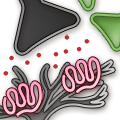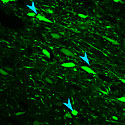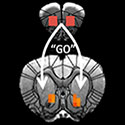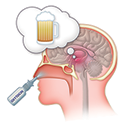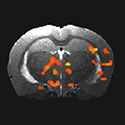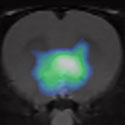Hot Off the Press – June 16, 2019. Brain stimulation is used to treat reward-related psychiatric diseases including addiction and treatment resistant depression. We report that high frequency stimulation parameters effective in treating these diseases promote the release of the peptide substance P. Release of this peptide in the Nucleus Accumbens rebalances excitatory input to… [Read More]
Hot off the Press
Neuron-Specific Genome Modification in the Adult Rat Brain Using CRISPR-Cas9 Transgenic Rats.
Hot Off the Press – May 10, 2019. Cell-specific CRISPR/Cas9 in the adult rat brain. Microscopic images of the midbrain of a transgenic rat that selectively expresses Cas9 in dopamine neurons. On the left side, control gRNAs were delivered to cells in the midbrain using a virus (green). On the right side, gRNAs to a… [Read More]
Compulsive drug use is associated with imbalance of orbitofrontal- and prelimbic-striatal circuits in punishment-resistant individuals
Hot Off the Press – May 6, 2019. We report that in a methamphetamine self-administration experiment, all rats show changes in the balance between “go” and “stop” brain circuits, however after foot shock punishment, behavior in the addictive subgroup is strongly correlated with the change in the balance of “go” and “stop” circuits, while the… [Read More]
Oxytocin blocks enhanced motivation for alcohol in alcohol dependence and blocks alcohol effects on GABAergic transmission in the central amygdala.
Hot Off the Press – April 22, 2019. The neuropeptide oxytocin blocks enhanced drinking in alcohol-dependent rats, according to a study published April 16 in the open-access journal PLOS Biology led by Drs. Tunstall, Koob and Vendruscolo of the National Institutes of Health, and Drs. Kirson and Roberto of The Scripps Research Institute. Targeting the… [Read More]
Ultrapotent chemogenetics for research and potential clinical applications.
Hot Off the Press – April 12, 2019. NIDA-funded scientists have just published findings in the journal Science showing the development of a new, groundbreaking chemogenetics technology for modulating brain function in a remote, precise and ultra-sensitive manner in living subjects. These findings describe new chemogenetic ion channels for neuron activation and silencing that are controlled by… [Read More]
Heroin addiction engages negative emotional learning brain circuits in rats
Hot Off the Press – April 8, 2019. The United States is amid an unprecedented opioid epidemic. From 2002 through 2016, the number of heroin users increased by 135% and the number of deaths attributable to heroin increased by 533%. Therefore, there is an urgent need for research into the neurobiology of opioid use disorder… [Read More]
Opioid-galanin receptor heteromers mediate the dopaminergic effects of opioids
Hot Off the Press – April 1, 2019. Identifying non-addictive opioid medications is a high priority in medical sciences, but μ-opioid receptors mediate both the analgesic and addictive effects of opioids. We found a significant pharmacodynamic difference between morphine and methadone that is determined entirely by heteromerization of μ-opioid receptors with galanin Gal1 receptors, rendering… [Read More]
A deeper insight into how GABA-B receptor agonism via baclofen may affect alcohol seeking and consumption: lessons learned from a human laboratory investigation.
Hot Off the Press – January 29, 2019. The GABA-B receptor agonist baclofen has been investigated and used as a treatment for alcohol use disorder, but data from clinical studies remain inconsistent. Additional research is needed to understand the biobehavioral mechanisms underlying baclofen’s effect in relation to alcohol use. In the present study, thirty-four alcohol-dependent… [Read More]
Genetic deletion of vesicular glutamate transporter in dopamine neurons increases vulnerability to MPTP-induced neurotoxicity in mice.
Hot Off the Press – November 29, 2018. The neural mechanisms underlying dopamine neuron degeneration in Parkinson’s disease are largely unknown. In this study, we found that selective deletion of a vesicular glutamate transporter (VgluT2) in dopamine neurons led to a significant increase in dopamine neuron toxicity to the neurotoxin MPTP via a BDNF-dependent mechanism,… [Read More]
Volitional social interaction prevents drug addiction in rat models.
Hot Off the Press – November 19, 2018. A new study published in Nature Neuroscience finds that social interactions can have a profound effect on behaviors related to addiction, and on the brain’s response to drug-associated cues. These findings have implications for people with substance use disorders (SUDs), because it suggests that social interaction can… [Read More]

